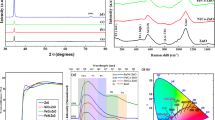Abstract
The etching reaction of silicon in HF-KMnO4-H2O mixed solution has been studied under various experimental conditions. The etch rates were measured as a function of agitation speed, HF and KMnO4 concentrations, and etching temperature and time. A comprehensive mechanism for the silicon etching and insoluble solid-phase film (K2SiF6) formation has been proposed. The holes formed at silicon surface accelerated not only the etch rate of silicon but also the formation rate of K2SiF6. With the increase of hole concentration at lower HF concentrations the etch rates decreased because of the deposition of K2SiF6 on etched silicon surface. Under the condition of sufficiently high HF concentration, the rate increased with the increase of hole formation and the formation of holes at silicon surface was the rate limiting step of the silicon etching reaction in HF-KMnO4-H2O solution. High HF concentration enough for dissolving K2SiF6 was apparently essential to obtain high etch rate in the silicon etching reaction.
Similar content being viewed by others
References
Eddowes, M. J., “Anodic Dissolution of p- and n-type Silicon, Kinetic Study of the Chemical Mechanism”,J. Electroanal. Chem.,280, 297 (1990).
Etman, M., Neumann-Spallart, M., Chazalviel, J. N. and Ozanam, F., “Kinetic and Diffusional Current Contribution in the Anodic Dissolution of p-Si Immersed in Fluoride Electrolytes”,J. Electroanal. Chem.,301, 259 (1991).
Genscher, H. and Lubke M., “Electrochemical Behavior of N-type Silicon(III)-Surfaces in Fluoride Containing Aqueous Electrolytes”. Bunsenges, Ber.Phys. Chem.,91, 394 (1978).
Huo, D. T., Yan, M. F., Wynn, J. D. and Wilt, D. P., “Chemical Etching of (001) InP by HBr-H2O2HCl Solution”,J. Electrochem. Soc.,136, 3094 (1989).
JCPDS (Joint Committee on Power Diffraction Standards), No. 7–217(1977).
Kelly, J. J. and Noyyen, P. H. L., “Hole Injection Reactions and Potential Distribution at the p-GaAs/Electrolyte Interface under Anodic Polarization”,Electrochem. Acta,29(5), 589 (1984).
Kikyuama, H., Miki, N., Saka, K., Takano, J., Kawanabe, I., Miyashita, M. and Ohmi, T., “Principles of Wet Chemical Processing in ULSI Microfabrication”,IEEE Transactions of Semiconductor Manufacturing,4(1), 26 (1991).
Matsumura, M. and Morrison, S. R., “Photoanodic Properties of an n-type Silicon Electrode in Aqueous Solutions Containing Fluorides”,J. Electroanal. Chem. 144, 113 (1983).
Memming, R. and Schwandt, G., “Hole Injection Reactions and Potential Distribution at the p-GaAs/Electrolyte Interface under Anodic Polarization”,Surf. Sci. 4, 109 (1966).
O’Commor, J. M., Dvorsky, E. F., Hier, H. S. and Reif, W. P., “Rapid Controlled Thinning of Gallium Arsenide”,J. Electrochem. Soc.,135, 190 (1988).
Ohmi, T., Morita, M., Teramoto, A., Makihara, K. and Tseng, K. S., “Very Thin Oxide Film on a Silicon Surface by Ultraclean Oxidation”,Appl. Phys. Lett.,60(17), 2126 (1992).
Schimmel, D. G. and Elkind, N. T., “An Examination of the Chemical Staining of Silicon”,J. Electrochem. Soc.,125, 152 (1978).
Seidel, H., Csepregi, L. Hewberger, A. and Baumgartel, H., “Anisotropic Etching of Crystalline Silicon in Alkaline Solutions. I. Orientation Dependence and Behavior of Passivation Layers”,J. Electrochem. Soc. 137(11). 3512 (1990).
Seo, Y. H., Yun, M. H., Nahm, K. S. and Lee, K. B., “Mechanism of Si Etching Reaction in Aqueous Solutions”,J. Vac. Sci. Technol. B,11(1), 70 (1993).
Seo, Y. H., Nahm, K. S., Hahn, Y. B. and Kim, C. B., “Reaction Kinetics of Silicon Etching in HF-K2Cr2O4-H2O Solution”,Korean J. of Chem. Eng.,11(2), 89 (1994).
Theunissen, M. J. J., Apples, J. A. and Verkuylen, W. H. C. G., “Application of Preferential Electrochemical Etching of Silicon to Semiconductor Device Technology”,J. Electrochem. Soc.,117, 959 (1970).
van den Meerakker, J. E. A. M. and van Vegchel, J. H. C. “Silicon Etching in CrO3-HF Solutions. II. Low [HF]/[CrO3] Ratios”,J. Electrochem. Soc,136(7), 1954 (1989).
Zhang, X. G., Collins, S. D. and Smith, R. L., “Porous Silicon Formation and Electropolishing of Silicon by Anodic Polarization in HP Solution”,J. Electrochem. Soc.,136(5), 1561 (1989).
Author information
Authors and Affiliations
Rights and permissions
About this article
Cite this article
Nahm, K.S., Seo, Y.H. Mechanism of silicon etching in HF-KMnO4-H2O solution. Korean J. Chem. Eng. 12, 162–167 (1995). https://doi.org/10.1007/BF02705641
Received:
Accepted:
Issue Date:
DOI: https://doi.org/10.1007/BF02705641




